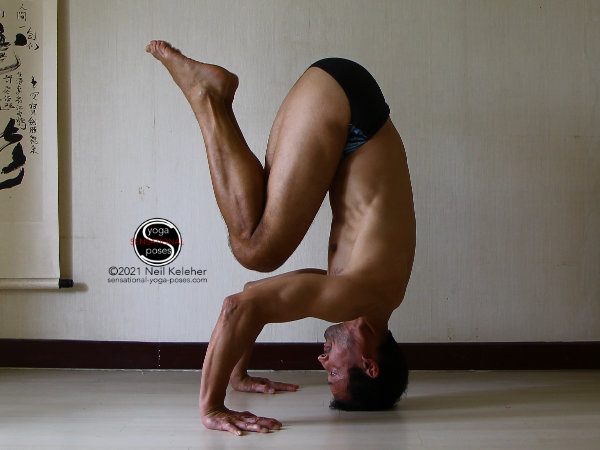Tripod Headstand
Getting Up and Staying Balanced
In yoga we tend to work on bound headstand as the default headstand. In that variation the hands are clasped (palms together or apart) behind the head. The head and the elbows thus form the base of this headstand variation.
An easier variation of headstand, and the one that most people tend to naturally adopt when attempting to "stand on their head" is tripod headstand. In tripod headstand the hands and the head form the base of the pose. Rather than using the hands to clasp each other, the hands are relatively free. The elbows are bent as if doing a push up and because the hands are relatively free, it's easier to position them relative to the head to form a larger base of support for the pose.
With a larger base of support its not only easier to lift the legs in this headstand variation. It's also a bit easier to stay balanced.
Basic precautions for tripod headstand
Even though tripod headstand is a relatively easy headstand, there is still the danger of falling. So first make sure that the area around you is clear in case you do fall.
Another good idea is to practice falling comfortably and safely. For that I'd suggest practicing forward rolling. Make sure you round your back as your roll. This is particularly important if you actually fall while in headstand.
Preparing your neck for headstand
While it is easier to use your arms to help support some portion of your body weight in headstand, particularly if you learn forwards, your neck is still going to be bearing a lot of weight.
You do not want your neck to be relaxed in this pose. Rather, your neck muscles should be engaged. One way to practice is to make your neck feel long. Pull your head back and up relative to your chest and focus on making the back of your neck feel long. Adjust chin drop up or down to find a position where your neck feels comfortably long.
Another thing you can try doing is bending forwards in front of a wall so that your torso is horizontal. Place your head against the wall. Use your hands initially. Position your body, neck and head so that you can make your neck feel long. Try pressing your head into the wall (Gradually!!!) to simulate some of the force your neck may be subject to while actually doing a headstand.
Going on all fours
Next, while on all fours, place your head on the floor. Position your hands relative to your head so that your hands and head form a triangle. The bigger the triangle, the easier it will be to stay balanced, to a point. Bend your elbows and position your hands so that your forearms are vertical.
Lift your knees and walk your feet towards your head to lift your hips.
Press your head down to activate your neck.
If you like, imagine trying to draw your ears away from your shoulders.
Press your hands down into the floor
Next, press your hands down strongly into the floor. Make your arms feel active. Keep your arms active and walk your feet closer to your head and your hips higher.
You'll reach a point where you can actually lift your feet off of the floor.
For the next few steps, rest whenever you need to.
Balancing pressure between hands and head
Rather than lifting your legs as high as you can straight away, see if you can move your hips and legs forwards or back just far enough that the pressure is relatively even between your head and your hands.
You may find it helpful to bend your knees to varying degrees.
Once you can find a position where pressure is even between your head and your hands, try bending your knees towards your chest while staying balanced.
I'd suggest getting used to holding this position for a few breaths. Then from there, try lift your knees forwards to about the height of your hips first. And then from there work at straightening your legs upwards. For each phase, work at keeping pressure even on your head and hands.
Try to do the same when lowering our legs.
What to do if you feel your weight shifting in tripod headstand
In any of the above balancing positions, if you feel your weight moving towards your hands you can increase the pressure from your hands to shift your weight back.
If you feel your weight moving towards your head then you can reduce the pressure of your hands to shift your weight forwards.
Published: 2016 01 31
Updated: 2021 08 31



